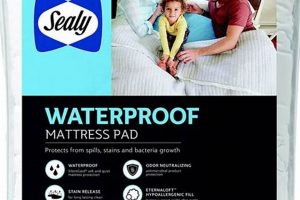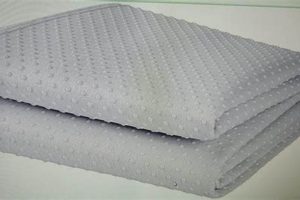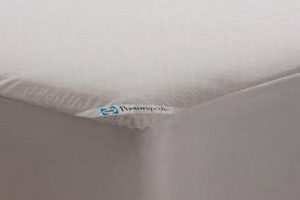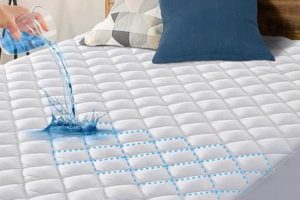A protective layer placed atop a mattress, shielding it from spills, stains, allergens, and dust mites, warrants regular cleaning. This safeguard extends the lifespan of the mattress and maintains a hygienic sleep environment. As an example, consider a scenario where accidental liquid exposure could permanently damage the underlying mattress; the protector serves as the initial barrier, preventing such harm.
The importance of maintaining a clean sleep surface is paramount for both hygiene and longevity. A properly maintained shield contributes significantly to a healthier sleep environment by reducing allergen and dust mite accumulation. Historically, methods for safeguarding mattresses have evolved from simple fabric coverings to technologically advanced, waterproof, and breathable barriers. These advancements highlight the increasing awareness of the benefits of a protected and clean mattress.
Understanding the proper methods for laundering this crucial bedding component is essential. The following information outlines general guidelines and considerations for effectively maintaining this item.
Washing Mattress Protectors
Proper laundering practices are critical to maintaining the integrity and effectiveness of mattress protectors. The following guidelines provide detailed instructions for cleaning procedures.
Tip 1: Check the Care Label: Prior to any washing, thoroughly examine the manufacturer’s care label. This label provides specific instructions regarding water temperature, drying methods, and permissible cleaning agents. Deviating from these instructions may damage the protector’s materials.
Tip 2: Pre-Treat Stains: Address any visible stains before placing the protector in the washing machine. A mild stain remover, applied directly to the affected area, can enhance the cleaning process. Ensure the stain remover is compatible with the protector’s fabric.
Tip 3: Use a Gentle Detergent: Select a mild, hypoallergenic laundry detergent to minimize the risk of allergic reactions and fabric damage. Avoid harsh chemicals such as bleach or fabric softeners, as these can compromise the protector’s waterproof or breathable properties.
Tip 4: Wash on a Gentle Cycle: Employ a gentle wash cycle with cold or lukewarm water, adhering to the care label’s recommendations. Overly aggressive washing can degrade the protector’s materials and reduce its protective capabilities.
Tip 5: Tumble Dry on Low Heat: If machine drying is permitted, use the lowest heat setting to prevent shrinkage or melting of synthetic components. Alternatively, air drying is often recommended to preserve the protector’s integrity.
Tip 6: Ensure Complete Drying: Before replacing the protector on the mattress, verify that it is completely dry. Residual moisture can promote mold or mildew growth, negating the cleaning efforts.
Tip 7: Regular Washing Frequency: Establish a consistent washing schedule, typically every one to two months, or more frequently if spills or accidents occur. Consistent cleaning maintains hygiene and prevents the accumulation of allergens.
Adhering to these guidelines helps maintain the effectiveness and longevity of the mattress protector, contributing to a healthier and more comfortable sleep environment.
The following section will address specific considerations for different types of protector materials.
1. Material Composition
The feasibility and methodology of laundering a mattress protector are intrinsically linked to its material composition. The fabrics and laminates used in construction directly dictate the appropriate water temperature, detergent type, and drying method. For example, a protector primarily composed of cotton may withstand higher wash temperatures compared to one incorporating polyurethane or vinyl. Understanding the material composition, as detailed on the care label, is therefore a prerequisite for selecting a suitable cleaning process.
Different materials react distinctively to laundering. Waterproof protectors often utilize a laminate that is sensitive to heat; improper drying can cause delamination, rendering the protector ineffective. Similarly, certain detergents can degrade the water-repellent treatments applied to some protectors. Consider a protector with a polyester knit surface laminated with a breathable polyurethane membrane; hot water could damage the membrane, while harsh detergents might strip the water-repellent finish on the knit. Thus, material characteristics exert a significant influence on washing parameters.
In summary, material composition is not merely an attribute of the mattress protector, but a determining factor in its washability. Careful examination of the materials and adherence to the manufacturer’s care instructions are paramount for preserving the integrity and functionality of the protector through the cleaning process. Ignoring this critical aspect can lead to damage, diminished protective capabilities, and premature replacement.
2. Water Temperature
Water temperature is a critical determinant in the successful laundering of a mattress protector. The appropriate temperature setting directly influences the cleaning efficacy and the preservation of the material’s structural integrity. Deviation from recommended temperatures can lead to irreversible damage, impacting the protector’s performance and lifespan.
- Material Sensitivity
Various materials used in mattress protectors exhibit distinct temperature sensitivities. For instance, polyurethane laminates, commonly found in waterproof protectors, are susceptible to degradation at high temperatures, potentially leading to delamination or cracking. Conversely, cotton-based protectors may tolerate warmer water, facilitating more effective stain removal. The manufacturer’s care instructions provide definitive guidance on the optimal temperature range for specific material compositions.
- Detergent Activation
Water temperature affects the activation and efficacy of laundry detergents. Certain detergents are formulated to perform optimally within a specific temperature range. Using water that is too cold may hinder the detergent’s ability to dissolve and effectively remove soils and stains. Conversely, excessively hot water can denature enzymes in some detergents, reducing their cleaning power. Therefore, matching the water temperature to the detergent’s recommended parameters is essential for achieving optimal cleaning results.
- Color Fastness
High water temperatures can promote dye bleeding, potentially causing discoloration of the mattress protector. This is particularly relevant for protectors with colored patterns or printed designs. Cold or lukewarm water is generally preferred to minimize the risk of dye transfer and maintain the protector’s original appearance. Pre-treating stains prior to washing can further reduce the need for higher temperatures and aggressive washing cycles.
- Shrinkage Potential
Elevated water temperatures can induce shrinkage in certain fabrics, particularly natural fibers like cotton. Shrinkage alters the protector’s dimensions, potentially rendering it ill-fitting for the mattress. This not only compromises the protector’s function but also necessitates replacement. Adhering to the recommended temperature range, typically cold or lukewarm, minimizes the risk of shrinkage and ensures a proper fit after laundering.
In summary, water temperature plays a pivotal role in whether a mattress protector can be effectively washed without compromising its integrity. Consideration of the material composition, detergent activation requirements, color fastness, and shrinkage potential is paramount. Following the manufacturer’s guidelines regarding water temperature is essential for ensuring a successful and damage-free laundering process, thereby extending the protector’s lifespan and maintaining its protective capabilities.
3. Detergent Type
The selection of detergent is a critical factor in determining the washability and longevity of a mattress protector. Improper detergent selection can compromise the protector’s material integrity, waterproof capabilities, and overall effectiveness.
- Harsh Chemicals
Detergents containing harsh chemicals, such as bleach or optical brighteners, can degrade the fibers and laminates used in mattress protectors. Bleach, in particular, can cause discoloration, weakening of the fabric, and compromise the waterproof membrane in many protectors. Therefore, avoiding detergents with these aggressive components is crucial.
- Enzymatic Cleaners
Enzymatic detergents are designed to break down organic stains like blood, sweat, and urine. While effective for stain removal, some enzymes can be too aggressive for delicate fabrics or laminates commonly found in mattress protectors. Protectors with sensitive waterproof layers may experience degradation over time with repeated exposure to high-enzyme detergents.
- Hypoallergenic Formulations
Hypoallergenic detergents, formulated without dyes, perfumes, and harsh chemicals, are generally the safest option for laundering mattress protectors. These detergents minimize the risk of allergic reactions and skin irritation, particularly important for individuals with sensitivities. They also tend to be gentler on the protector’s materials, extending its lifespan.
- Residue Buildup
Certain detergents can leave behind a residue on the fabric, even after rinsing. This residue can attract dust mites and allergens, counteracting the protector’s intended function. Furthermore, residue buildup can compromise the breathability of the protector, leading to increased heat retention and discomfort. Selecting a detergent that rinses clean is essential for maintaining the protector’s hygienic properties.
The appropriate detergent type directly impacts the feasibility and outcome of washing a mattress protector. By opting for hypoallergenic, residue-free detergents and avoiding harsh chemicals and overly aggressive enzymes, one can effectively clean the protector while preserving its integrity and functionality. Consideration of detergent composition is, therefore, paramount for responsible care of this essential bedding item.
4. Drying Method
The selection of a suitable drying method directly influences the outcome of laundering a mattress protector. The chosen technique can either preserve the protector’s integrity and functionality or lead to its degradation, thus making the drying method of great importance when considering, Can I wash a mattress protector?
- High Heat Exposure
Elevated temperatures generated by conventional tumble dryers pose a significant risk to certain mattress protector materials, particularly those incorporating waterproof membranes or synthetic components. Excessive heat can cause delamination of the waterproof layer, shrinkage of the fabric, or melting of synthetic fibers, rendering the protector ineffective and potentially necessitating its replacement. An example of this is a polyurethane-laminated protector subjected to high dryer heat, resulting in irreversible damage to the membrane and loss of waterproof properties.
- Air Drying Practices
Air drying presents a gentler alternative, mitigating the risks associated with high heat. However, proper air drying requires adequate ventilation and time to prevent the growth of mold or mildew within the protector’s layers. Insufficient airflow or prolonged drying times, particularly in humid environments, can lead to the development of unpleasant odors and compromise the protector’s hygienic properties. It may also take extended amounts of time to dry the protector if the ventilation is not good.
- Tumble Drying Guidelines
If tumble drying is deemed permissible by the manufacturer’s care instructions, adherence to low heat settings is crucial. Low heat minimizes the risk of material degradation while still facilitating efficient drying. Regularly monitoring the protector during the drying cycle prevents overheating. Some protectors may require only a brief tumble dry followed by air drying to ensure complete dryness without exposing the materials to prolonged heat. These settings will help improve the protectors dryness while protecting the item itself.
- Residual Moisture Concerns
Regardless of the drying method employed, ensuring complete dryness before remitting the mattress protector to the bed is paramount. Residual moisture can create a breeding ground for mold, mildew, and bacteria, compromising the hygiene of the sleeping environment and potentially damaging the mattress itself. Thoroughly inspecting the protector for any dampness, particularly in seams and corners, is essential before reuse. You should also consider leaving it out for another hour or two to make sure it is completely dry.
The choice of drying method is not merely a procedural step, but a critical decision that directly affects the longevity and effectiveness of the mattress protector. Selecting a method appropriate for the protector’s material composition, and ensuring complete dryness, are essential for maintaining a hygienic and protected sleep environment after laundering.
5. Frequency
The frequency with which a mattress protector is laundered significantly impacts its effectiveness and lifespan. Establishing an appropriate washing schedule is crucial for maintaining a hygienic sleep environment and preserving the protector’s material integrity. Infrequent washing allows for the accumulation of allergens, dust mites, and bodily fluids, potentially compromising the protector’s primary function of safeguarding the mattress. Conversely, excessively frequent washing can accelerate wear and tear, diminishing the protector’s waterproof capabilities or causing premature degradation of its fabric.
The ideal washing frequency depends on several factors, including usage patterns, environmental conditions, and individual sensitivities. For instance, a protector used in a guest room with minimal occupancy may require less frequent cleaning compared to one used nightly by an individual prone to night sweats or allergies. Homes with pets or young children may necessitate more frequent washing due to increased exposure to allergens and spills. As a practical example, a family with a toddler who occasionally wets the bed might benefit from washing the protector weekly, while a single adult with no allergies could extend the interval to every two months. Ignoring those factors can decrease the item’s longevity.
In conclusion, determining an appropriate washing frequency is a critical component of responsible mattress protector care. Balancing hygiene needs with the potential for material degradation requires careful consideration of individual circumstances and adherence to the manufacturer’s care instructions. Regular assessment of the protector’s condition and adjustment of the washing schedule accordingly ensures that it continues to provide optimal protection and contribute to a healthy sleep environment.
6. Waterproof Integrity
The ability to launder a mattress protector hinges significantly on the maintenance of its waterproof integrity. The presence of a functional waterproof layer is often the primary reason for using a protector, shielding the mattress from spills, stains, and other liquids. Therefore, the impact of washing on this protective barrier warrants careful consideration.
- Laminate Degradation
Many mattress protectors achieve waterproofness through a laminate applied to the fabric. Repeated washing, particularly with harsh detergents or at high temperatures, can degrade this laminate. Delamination, cracking, or pinholing can compromise the barrier, rendering the protector ineffective. For example, a polyurethane laminate may become brittle and crack after multiple washes at temperatures exceeding the manufacturer’s recommendations, leading to water penetration and ultimately defeating the purpose of the protector.
- Seam Sealing Failure
Seams represent a vulnerable point in the waterproof integrity of a mattress protector. While the fabric itself may be waterproof, the seams require specialized sealing to prevent liquid penetration. Washing can stress these seals, causing them to weaken or fail over time. A common scenario involves the seam tape peeling away from the fabric after several wash cycles, creating gaps through which liquids can pass. Regular inspection of seams after washing is crucial to identify any signs of deterioration.
- Water Repellent Treatment Loss
Some mattress protectors rely on a durable water repellent (DWR) treatment applied to the fabric surface for initial liquid resistance. While not strictly a waterproof layer, DWR enhances the protector’s ability to repel spills and prevent immediate absorption. Washing, particularly with harsh detergents or fabric softeners, can strip this treatment, diminishing the protector’s initial repellency. A protector with a compromised DWR may absorb spills more readily, increasing the risk of liquids reaching the mattress.
- Material Swelling and Distortion
Repeated exposure to water and detergent can cause some mattress protector materials to swell or distort. This distortion can create gaps or wrinkles in the waterproof layer, compromising its ability to form a continuous barrier. For example, a protector with a cotton blend fabric may shrink or stretch unevenly after washing, leading to gaps around the edges or corners that allow liquid to seep through.
In summary, maintaining waterproof integrity is paramount when assessing the washability of a mattress protector. The potential for laminate degradation, seam sealing failure, water repellent treatment loss, and material distortion all contribute to the overall impact of laundering on the protector’s performance. Following the manufacturer’s care instructions and employing gentle washing practices are essential for preserving the waterproof properties and ensuring the continued effectiveness of this bedding item.
Frequently Asked Questions
The following provides answers to common inquiries regarding the proper washing and care of mattress protectors.
Question 1: How often should a mattress protector be washed?
The recommended washing frequency varies based on usage and individual needs. A general guideline suggests laundering every one to two months. However, protectors used in environments with higher exposure to allergens, spills, or bodily fluids may require more frequent washing.
Question 2: Is it necessary to pre-treat stains on a mattress protector?
Pre-treating stains prior to washing is advisable. Addressing stains promptly increases the likelihood of complete removal and prevents permanent discoloration. Mild stain removers, compatible with the protector’s fabric, are recommended.
Question 3: What type of detergent is best for washing a mattress protector?
A mild, hypoallergenic detergent is generally recommended. Harsh chemicals, bleach, and fabric softeners should be avoided, as they can damage the protector’s materials and compromise its waterproof properties.
Question 4: Can a mattress protector be machine dried?
Whether a mattress protector can be machine dried depends on its material composition and the manufacturer’s instructions. If permitted, tumble drying on a low heat setting is recommended. Air drying is often a gentler alternative that minimizes the risk of damage.
Question 5: How can shrinkage be prevented when washing a mattress protector?
Shrinkage can be minimized by using cold or lukewarm water and avoiding high heat during drying. Adhering to the manufacturer’s care instructions regarding temperature settings is crucial.
Question 6: How to deal with a protector that no longer seems waterproof after washing?
If a mattress protector loses its waterproof integrity after washing, it may indicate damage to the waterproof laminate or seam seals. A damaged protector should be replaced to ensure continued protection of the mattress.
Proper laundering techniques and adherence to manufacturer guidelines contribute to the prolonged effectiveness and lifespan of a mattress protector.
The following section provides an overview of common issues and troubleshooting tips related to mattress protector care.
Concluding Remarks
The preceding discussion has elucidated the multifaceted aspects of laundering a mattress protector. Critical considerations encompass material composition, water temperature, detergent selection, drying method, and washing frequency. Adherence to manufacturer guidelines and judicious application of appropriate cleaning techniques are paramount in preserving the protector’s functionality and extending its lifespan. The question, “Can I wash a mattress protector?” necessitates a nuanced understanding of these variables.
Responsible management of this bedding component contributes directly to a healthier and more hygienic sleep environment. Neglecting proper care protocols risks compromising the protector’s integrity, diminishing its protective capabilities, and potentially necessitating premature replacement. Therefore, informed decision-making and diligent execution of recommended washing practices are essential for maximizing the value and benefits derived from the mattress protector.





![Cool Tempur-Pedic Comfort: Cooling Mattress Protector [Guide] Organic & Natural Mattress Buyer’s Guide: Non-Toxic Sleep Solutions Cool Tempur-Pedic Comfort: Cooling Mattress Protector [Guide] | Organic & Natural Mattress Buyer’s Guide: Non-Toxic Sleep Solutions](https://mattressworldpa.com/wp-content/uploads/2025/07/th-2523-300x200.jpg)

